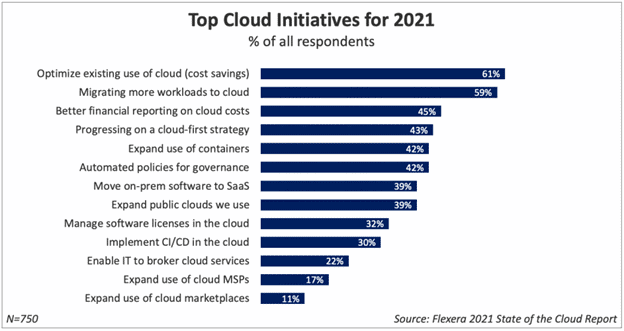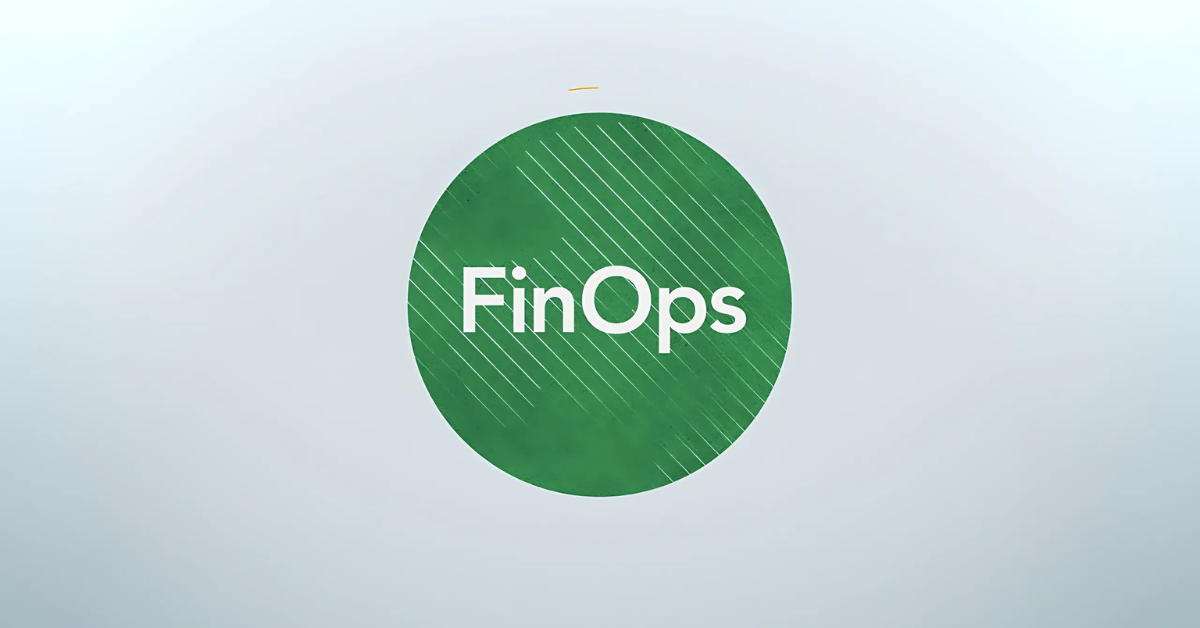Cloud Computing and Financial Management: Maximizing the Potential of the Cloud
Cloud computing offers businesses an arsenal of powerful, scalable, and flexible tools. However, decentralizing access to cloud resources, especially in hybrid cloud environments, presents significant challenges, such as runaway costs and lack of visibility. This reality makes it difficult to control IT budgets and financial management, known as Cloud Financial Management or FinOps.
To overcome these obstacles and ensure your organization’s success in the cloud, it is crucial to develop a comprehensive cloud financial management strategy that aligns with your cloud strategy.
World Cloud State Survey
The report Flexera 2021 State of the Cloud Report provides valuable insights into the public, private and multi-cloud market. It explores the current and future strategies of 750 global cloud decision-makers and users, revealing important trends.
“The COVID-19 pandemic has accelerated the shift to cloud computing,” said Jim Ryan, president and CEO of Flexera. “Companies are moving quickly, facing challenges and looking to connect cloud computing to business outcomes.”
The report highlights that the appetite for digital transformation is high, but real-world challenges such as managing security and optimizing cloud spend still need to be overcome.

Key Highlights from the Flexera 2021 State of the Cloud Report:
- Multi-cloud adoption: 92% of companies adopt a multi-cloud strategy, while 80% opt for a hybrid cloud strategy.
- Public Cloud Acceleration: 31% of enterprises spend more than US$12M per year in public cloud, and 54% of enterprise workloads are expected to be in the public cloud within 12 months.
- Impact of COVID-19: 90% of respondents expect cloud usage to exceed plans due to the pandemic.
- Cost optimization: 61% of companies plan to optimize cloud costs in 2021, making it the top initiative for the fifth consecutive year.
- Cloud migration: 59% of power users consider cloud migration a key initiative.
- Success metrics: 76% of companies use cost efficiency and economics to measure cloud progress.
- Centralized approach: 75% of companies have a central cloud team or center of excellence (CCoE).
- AWS Leadership and Azure Growth: AWS leads the market with 77% adoption, followed by Azure with 73% and Google Cloud with 47%.
What is Cloud Financial Management or Cloud Financial Management FINops?
Cloud Financial Management (CFM) is also known in the market as FinOps or Cloud Cost Management. It can be classified as an area that helps to align and develop financial goals, drive a cost-conscious culture, establish guardrails to meet financial goals, and achieve greater business efficiencies.
The ever-changing nature of cloud services, as well as your dynamic and evolving business objectives, will require your Cloud Financial Management FINops to be extremely adaptable.
The right CFM FINOps can help you optimize and better manage your cloud costs, but only if it is treated as an ongoing process and embedded in the culture and collaboration between areas, teams and projects across your organization. This model will bring positive impacts on the governance of your financial costs in clouds such as AWS, Azure, Google Cloud and Vmware.
Building a Cloud Financial Management CFM FinOps Success can be achieved by companies of different sizes as it involves the establishment in modules of the following four main pillars: visibility, optimization, automation and governance with business integration.
In order to help ensure that CFM Cloud Financial Management starts with a solid foundation and remains successful long after its implementation, a comprehensive, multidisciplinary and collaborative working group needs to be at the forefront of this “project”. Today companies with greater Cloud maturity are creating a Cloud Center of Excellence (CCoE) sometimes known as a Cloud Strategy Office or Cloud Program office with a focus on FinOps.
The main pillars of FINops:
Ensuring that technology, business and finance professionals are brought together with a new set of processes can lead to good FINops practice. Generally speaking, the journey of the FinOps it has three phases or pillars: inform, optimize and operate.
Inform
This is the first phase of the journey of the FinOps. It is the phase responsible for giving visibility. I often say that the foundation in Cloud Computing is knowing what is being spent what, where is it being spent and who is spending it.
It is, in fact, essential for empowering organizations and teams on issues such as visibility, allocation, benchmarking, budgeting and forecasting. Since the nature of the cloud is quite elastic in terms of usage and pricing, teams need accurate visibility to make assertive decisions.
optimize
Once organizations and teams are empowered, they need to optimize their cloud presence over and over again in a PDCA model. Thus, teams can optimize the environment by scaling the platform and disabling unnecessary features.
Based on the information generated by the first phase, it is possible to optimize the cost in several ways. Cleaning the environment, resizing, changing the type of instances, booking instances and even changes in the architecture of a solution.
Operate
THE migration to cloud it will only be successful if the company manages to build a culture of FinOps very wide. Therefore, this culture must involve a cloud cost center or Cloud Center of Execellence, including commercial, financial and operational teams that also define the appropriate governance.
FinOps: Inform, optimize and operate
The adoption of the FinOps methodology, performed consistently, using the best practices and with the appropriate tools, allows the creation of a virtuous cycle that, in the end, brings Organizations the benefits of control and saving of resources and the possibility of adopting new services. cloud that are actually useful to the business.
This process is based on 3 fundamentals, which are:
- Visibility of resource use, with constantly updated data and consumption history. View of resource allocation, business areas, systems, etc.
- Taking the necessary actions that make good business sense. Modification of hiring plans, alteration of consumption regions, “rightsizing” decisions or even deactivation of services.
- Search for continuous improvement based on the adoption of recognized practices, benchmarking, speed of delivery and cultural change.
In this sense, among the common practices we have:
- Elimination of underused or unused resources.
- Changing Snapshot Retention
- Storage tier change.
- Purchase of reserved resources.
- Right-size” & “Right-family” actions.
- Use of “spot” instances.
What is the structure proposed by the FINOps foundation to operate a Cloud Excellence Center?

FinOps Best Practices from CIO.com
Regardless of whether companies adhere to guidelines or best practices in their own cloud governance projects, Cio.com says there are four main strategies for managing cloud spending:
1. Determine who is spending what.
To do this, you need to “tag” your features or find out which features an app accesses. This is particularly important in companies where thousands of people access hundreds of apps.
2. Do not use a lawn mower when a shrub trimmer will do.
Do you have the right EC2 instance for the compute workload you need, or are you over-provisioning? Use and pay for only what you need.
3. Rationalize spending.
Consider using Reserved Instances, a reserve of resources and capacity for a specific Availability Zone within a region. This lets you buy the computing power you know you'll need, at a lower cost than purchasing on demand.
4. Create apps suitable for the cloud.
If you're a high-volume transaction business, that means designing your applications to scale out, allowing you to add or subtract resources as needed.
Cloud Center of Excellence (CCoE)
The Cloud Center of Excellence (CCoE) is a cross-functional group that governs cloud usage, driving best practices across the organization. Its primary responsibilities include:
- Execute the cloud strategy.
- Promote collaboration and best practices, such as Tagging Management.
- Evaluate and utilize cloud technologies to support business initiatives.
The CCoE creates a culture of financial awareness (FinOps) and accountability, essential to the success of CFM FinOps.
If you'd like to learn more about how to build your own Cloud Financial Management strategy, we've made this original article available from the site. VMware.
Did you know that the 4MATT Technology Are your consultants PIONEERS in Brazil in Software Governance, FINops and Cloud Center of Excellence?
Do you want results and good management of your cloud? Contact us
Tag: digital transformation, cloud cost, innovative technologies, cost reduction, fenops foundation, cloud spend, cloud costs, systems architecture, it solutions, apply in cloud, contact center, digital business, solution architecture, fenops practice, web application firewall, data lake, cloud migration, IT infrastructure, website reliability, engineering, business transformation, Finops framework, edge computing, databases, public cloud, customer portal, relational content, Finops understand, optimize costs, model operational, microsoft azure, cloud costs, disaster recovery, cloud cost, artificial intelligence, talk to an expert, endpoint security, it market, market spokesperson, private cloud, technology business, reduce costs, Marcelo Theophilo, cost management , hybrid cloud, cloud usage, cloud cost, google cloud, cloud Finops, Finops team, Finops practitioners, Red Hat, information security, cost management, cloud computing, cost optimization, disaster recovery, cloud consumption, best practices for optimization, Finops, sap basis, cloud costs, cloud cost, operating model, cloud costs, apply in cloud, business transformation, private cloud, disaster recovery, microsoft azure, market spokesperson, IT market, digital business, website reliability engineering, contact us, fenops practitioners, it infrastructure
managed in the cloud, cloud providers, web application firewall, best practices for optimization, relational content, finaps understand, solution architecture, systems architecture, it solutions, reduce costs, endpoint security, customer portal, talk to an expert, databases, edge computing, innovative technologies, artificial intelligence, cost optimization, finaps team, cloud spend, contact center, data lake, cost reduction inops can help what are the principles operating in the cloud claranet brazil asset management software decision making resource optimization customer experiences variable costs cost management lifecycle cloud management create applications what resources sap basis cloud fenops cloud costs fenops framework


